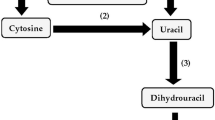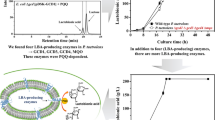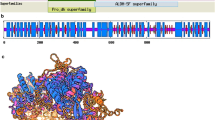Abstract
Catabolism of uracil and thymine in Burkholderia cepacia ATCC 25416 was shown to occur using a reductive pathway. The first pathway enzyme, dihydropyrimidine dehydrogenase, was shown to utilize NADPH as its nicotinamide cofactor. Growth of B. cepacia on pyrimidine bases as the nitrogen source instead of on ammonium sulfate increased dehydrogenase activity at least 32-fold. The second and third reductive pathway enzymes, dihydropyrimidinase and N-carbamoyl-β-alanine amidohydrolase, respectively, exhibited activities elevated more than 21-fold when pyrimidine or dihydropyrimidine bases served as the nitrogen source rather than ammonium sulfate. The pathway enzyme activities were induced after growth on 5-methylcytosine.
Similar content being viewed by others
Author information
Authors and Affiliations
Additional information
Received: 17 January 1997 / Accepted: 5 May 1997
Rights and permissions
About this article
Cite this article
West, T. Reductive catabolism of uracil and thymine by Burkholderia cepacia. Arch Microbiol 168, 237–239 (1997). https://doi.org/10.1007/s002030050493
Issue Date:
DOI: https://doi.org/10.1007/s002030050493




